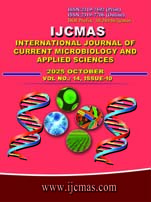


 National Academy of Agricultural Sciences (NAAS)
National Academy of Agricultural Sciences (NAAS)

|
PRINT ISSN : 2319-7692
Online ISSN : 2319-7706 Issues : 12 per year Publisher : Excellent Publishers Email : editorijcmas@gmail.com / submit@ijcmas.com Editor-in-chief: Dr.M.Prakash Index Copernicus ICV 2018: 95.39 NAAS RATING 2020: 5.38 |
Extended-spectrum β-lactamase producing Gram negative bacilli constitute a global public health threat. The ESBLs CTX-M, TEM and SHV remain the most frequently isolated worldwide, with high proportions of CTX-M reported and widely distributed in pathogens. Several authors report that the bacterial strains harboring the CTX-M-15 gene are generally multidrug-resistant strains. This study aim to identify the variants of blaCTX-M, blaTEM and blaSHV hosted by Gram negative bacilli at hospital center Yalagdo Ouédraogo. This study take on bacterial strains collected in a previous study (DOI: 10.5897/AJB2014.13908). Bacterial strains had been isolated from biological samples such as stools, urine, blood, cerebrospinal fluid, effusion fluids (pus, ascitic fluid, pleural fluid...) and genital swabs.. During this previous study, 259 strains resistant to at least one third-generation cephalosporin had been collected and identified using API20E. This study had shown that some of these bacterial strains harbor blaCTX-M, blaTEM and blaSHV. For the present study, from a young bacterial culture, genomic DNA extraction was performed by the boiling method and conventional PCR was used to confirm the presence of resistance genes. PCR products from a total of 17 bacterial strains were subjected to Sanger sequencing for genes variants determination. In the previous study, among 259 strains collected, molecular characterization had shown that 112 strains (65.49%) were positive for blaCTX-M screening; 44 strains (25.73%) for blaTEM screening and 32 strains (18.71%) for blaSHV. For the present study, among 17 bacterial strain consisting to 7 Escherichia coli, 4 Klebsiella pneumoniae, 3 Pseudomonas aeruginosa, 1 Enterobacter sp, 1 Citrobacter sp and 1 Salmonella tiphy, blaCTX-M-15 and blaSHV-28 genes were found respectively on 82.35% and 5.88% of all bacterial strains analyzed, while the blaTEM-1 and blaSHV-11 were each harbored by 23.53% of the isolates. The current situation of bacterial resistance remains dominated by the spread of broad-spectrum beta-lactamases. A high proportion of bacterial strains studied resist by production of ESBLs type CTX-M-15. Measures must be implemented to slow the emergence and spread of ESBL-producing Gram-negative bacilli through the appropriate use of antibiotics.
Ahmad I, Malak HA, Abulreesh HH (2021). Environmental antimicrobial Resistance and its drivers: a potential threat to public health. Journal of Global Antimicrobial Resistance, 27: https://doi.org/10.1016/j.jgar.2021.08.001
Ahoyo AT, Baba-Moussa L, Anago AE, Avogbe P, Missihoun TD, Loko F., Prévost G, Sanni A, Dramane K (2007). Incidence of infections dues to Escherichia coli strains producing extended spectrum betalactamase, in the Zou/Collines Hospital Centre (CHDZ/C) in Benin. Médecine et Maladies Infectieuses. 37(11), 746-752
Alfaresi MS, Elkoush AA (2010) Real-time polymerase chain reaction for rapid Detection of genes encoding SHV extended-spectrum β-lactamases. Indian Journal of Medical Microbiology. 28:332-336. https://doi.org/10.4103/0255-0857.71827
Bevan ER, Jones AM, Hawkey PM (2017) Global epidemiology of CTX-M β lactamases: temporal and geographical shifts in genotype. Journal of antimicrobial chemotherapy, 72:2145-2155. https://doi.org/10.1093/jac/dkx146
Blomberg B, Jureen R, Manji KP, Tamim BS, Mwakagile DS, Urassa WK, Fataki M, Msangi V, Tellevik MG, Maselle SY, Langeland N. (2005). High rate of fatal cases of Pediatric septicemia caused by gram-negative bacteria with extended-spectrum b-lactamases in Dar es Salaam, Tanzania. J Clin Microbiol. 43, 745–749
Bonnet R (2004). Growing group of extended-spectrum β-lactamases: the CTX-M enzymes. Antimicrob. Agents Chemother. 48:1-14. https://doi.org/10.1128/aac.48.1.1-14.2004
Canton R, Morosini M., Martin O, et al., (2008). IRT and CMT β?lactamases and inhibitor resistance. Clinical microbiology and infection, 14, 53-62. https://doi.org/10.1111/j.1469-0691.2007.01849.x
CA-SFM (2023). Comité de l’Antibiogramme de la Société Francaise de Microbiologie: Recommandations.
Del Carmen Rocha-Gracia R, Lozano-Zarain P, Cázarez ZG et al., (2022). IncFIB plasmids carrying the resistance gene blaCTX-M-15 in ESBL-producing Escherichia coli clones from pediatric patients. The Journal of Infection in Developing Countries, 16:500-506. https://doi.org/10.3855/jidc.15080
Dembélé R, Konaté A, Traoré O, Kaboré WAD, Soulama I, Kagambèga A, Traoré AS, Guessennd NK, Aidara-Kane A, Gassama-Sow A, Barro N. (2020). Extended spectrum beta-lactamase and fluoroquinolone resistance genes among Escherichia coli and Salmonella isolates from children with diarrhea, Burkina Faso. BMC Pediatr. 20(1):459. https://doi.org/10.1186/s12887-020-02342-z. PMID: 33010801; PMCID: PMC7532561.
Dhanji H, Doumith M, Rooney PJ et al., (2011). Molecular epidemiology of fluoroquinolone resistant ST131Escherichia coli producing CTX-M extendedspectrum b-lactamases in nursing homes in Belfast, UK. J Antimicrob Chemother, 66: 297–303. https://doi.org/10.1093/jac/dkq463
Doma AO, Popescu R, Mitule?u M, et al., (2020). Comparative Evaluation of qnrA, qnrB, and qnrS Genes in Enterobacteriaceae Ciprofloxacin-Resistant Cases, in Swine Units and a Hospital from Western Romania. Antibiotics 9:698. https://doi.org/10.3390/antibiotics9100698
Drawz SM, Bonomo RA (2010). Three decades of beta-lactamase inhibitors. Clin Microbiol Rev 23:160-201. https://doi.org/10.1128/CMR.00037-09
Gibold L, Robin F, Tan RN et al., (2014). Four-year epidemiological study of extended spectrum β-lactamase-producing Enterobacteriaceae in a French teaching hospital. Clin Microbiol Infect. 20:20-26. https://doi.org/10.1111/1469-0691.12321
Han Y, Huang L, Liu C, et al., (2021). Characterization of Carbapenem-Resistant Klebsiella pneumoniae ST15 Clone Coproducing KPC-2, CTX-M-15 and SHV-28 Spread in an Intensive Care Unit of a Tertiary Hospital. Infection and Drug Resistance. 14:767-773. https://doi.org/10.2147/IDR.S298515
Harrois D, Breurec S, Seck A, Delaune A, Le Hello S, Pardos de la Gandara M, Sontag L, Perrier-Gros-Claude JD, Sire JM, Garin B, and FX. Weill1. (2014). Prevalence and characterization of extended-spectrum b-lactamase-producing clinical Salmonella enterica isolates in Dakar, Senegal, from 1999 to 2009. Clin Microbiol Infect; 20: O109–O116. https://doi.org/10.1111/1469-0691.12339
Kumar A, Kumar A (2021). Antibiotic resistome of Salmonella typhi: molecular determinants for the emergence of drug resistance. Frontiers of Medicine, 15(5), 693-703. https://doi.org/10.1007/s11684-020-0777-6
Kpoda DS, Ajayi A, Somda M, Traore O, Guessennd N, Ouattara AS, Sangare L, Traore AS, Dosso M (2018). Distribution of resistance genes encoding ESBLs in Enterobacteriaceae isolated from biological samples in health centers in Ouagadougou, Burkina Faso. BMC Res Notes.11(1):471. https://doi.org/10.1186/s13104-018-3581-5
Lonchel CM, Melin P, Gangoué-Piéboji J, Assoumou MC, Boreux R, De Mol P (2013). Extended-spectrum β-lactamase-producing Enterobacteriaceae in Cameroonian hospitals. Eur J Clin Microbiol Infect Dis, 32(1):79-87. https://doi.org/10.1007/s10096-012-1717-4
Meeta S, Sati P, Preeti S (2013). Prevalence and antibiogram of Extended-Spectrum β Lactamase (ESBL) producing Gram negative bacilli and further molecular characterization of ESBL producing Escherichia coli and Klebsiella spp; Journal of Clinical and Diagnostic Research. 7:2173-2177. https://doi.org/10.7860/JCDR/2013/6460.3462
Mètuor Dabiré A, Zongo K.J., Zeba B, et al., (2014). First detection of shv-type extended spectrum β-lactamases in the university hospital complex paediatric Charles De Gaulle (chup-cdg) of Ouagadougou in burkina faso. Journal of Asian Scientific Research. 4:214-221
Mutuku C, Gazdag Z, Melegh S (2022). Occurrence of antibiotics and bacterial resistance genes in wastewater: resistance mechanisms and antimicrobial resistance control approaches. World J Microbiol and Biotechnol, 38:9, 152. https://doi.org/10.1007/s11274-022-03334-0
Muhigwa M, Sanou S, Kantagba D, Ouangraoua S, Yehouenou CL, Michodigni F, Poda A, Perris Renggli E, Bernasconi A, Godreuil S, Ouedraogo AS. (2023). Characterization of extended-spectrum beta-lactamase and carbapenemase genes in bacteria from environment in Burkina Faso. J Infect Dev Ctries. 17(12):1714-1721. https://doi.org/10.3855/jidc.18116.
Naas T, Oueslati S, Bonnin RA, Dabos ML, Zavala A, Dortet L et al., (2017). Beta-lactamase database (BLDB) - structure and function. J Enzyme Inhib Med Chem.; 32: 917-919.
Ndugulile F, Jureen R, Harthug S, et al., (2005) Extended Spectrum β-Lactamases amongGram negative bacteria of nosocomial origin from an Intensive Care Unit of a tertiary health facility in Tanzania. BMC Infect Dis. 5:86. https://doi.org/10.1186/1471-2334-5-86
Nicolas-Chanoine MH (2012). Les entérobactéries productrices de bêta-lactamases à spectre élargi : où sont les dangers? Réanimation 21:260-267 https://doi.org/10.1007/s13546-012-0463-z
Oliver A, Weigel LM, Rasheed JK, et al., (2002). Mechanisms of decreased susceptibility to cefpodoxime in Escherichia coli. Antimicrob. Agents Chemother. 46:3829-3836. https://doi.org/10.1128/aac.46.12.3829-3836.2002
Ouedraogo AS, Sanou M, Kissou A, Sanou S, Solaré H, Kaboré F, Poda A, Aberkane S, Bouzinbi N, Sano I, Nacro B, Sangaré L, Carrière C, Decré D, Ouégraogo R, Jean-Pierre H, Godreuil S. (2016). High prevalence of extended-spectrum ß-lactamase producing enterobacteriaceae among clinical isolates in Burkina Faso. BMC Infect Dis. 16:326. https://doi.org/10.1186/s12879-016-1655-3.
Pagani L, Dell'Amico E, Migliavacca R (2003). Multiple CTX-M-type extended- spectrum β- lactamases in nosocomial isolates of Enterobacteriaceae from a hospital in Northern Italy. J. Clin. Microbiol. 41:4264-4269. https://doi.org/10.1128/jcm.41.9.4264-4269.2003
Pemberton OA, Noor RE, Kumar MV et al., (2020). Mechanism of proton transfer in class A β-lactamase catalysis and inhibition by avibactam. Proceedings of the National Academy of Sciences, 117:5818-5825. https://doi.org/10.1073/pnas.1922203117
Potron A, Nordmann P, Rondinaud E et al., (2013). A mosaic transposon encoding OXA-48 and CTX-M-15: towards pan-resistance. J Antimicrob Chemother; 68: 476-7. https://doi.org/10.1093/jac/dks397
Ribei ro Junior JC, Tamanini R, Soares BF, Marangon de Oliveira A, Silva F (2016). Efficiency of boiling and four other methods for genomic DNA extraction of deteriorating spore-forming bacteria from milk. Agricultural Sciences 37(5):3069-3078.
Sarr H, Niang AA, Diop A et al., (2023). The emergence of carbapenem-and colistin-resistant enterobacteria in Senegal. Pathogens, 12:8. https://doi.org/10.3390/pathogens12080974
Shah AA, Hasan F, Ahmed S and Hameed A (2004). Extended-Spectrum β-Lactamases (ESBLs): Characterization, Epidemiology and Detection. Critical Reviews in Microbiology, 30(1), 25–32. https://doi.org/10.1080/10408410490266429
Strahilevitz J., Jacoby G.A., Hooper D.C., Robicsek A. (2009). Plasmid-Mediated Quinoloneesistance: A Multifaceted Threat. Clin.Microbiol. Rev. 22, 664-689 154. Suzan E.F., Ashraf E., Reem H. (2007). Phenotypic and Molecular Detection of TEM and SHV β-Lactamases Produced by organisms of the family Enterobacteriaceae; Study on Blood Culture Clinical Isolates from Intensive Care Unit. Egyptian Journal of Medical Microbiology. Vol. 16, No. 2
Tooke CL, Hinchliffe P, Lang PA, et al., (2019). Molecular basis of class A beta-lactamase inhibition by relebactam. Antimicrob Agents Chemother 63: e00564-19. https://doi.org/10.1128/aac.00564-19
Tsering DC, Das S, Adhiakari L et al., (2009). Extended Spectrum Beta lactamase Detectionin Gram-negative Bacilli of Nosocomial Origin. Journal of Global Infectious Diseases, 1: 87-92. https://doi.org/10.4103/0974-777X.56247
Wang Z, Koirala B, Hernandez Y, Zimmerman M, Park S, Perlin DS, and Brady SF. (2022). “A Naturally Inspired Antibiotic to Target Multidrug-Resistant Pathogens.” Nature 601 (7894): 606-11. https://doi.org/10.1038/s41586-021-04264-x.
Woerther PL, Burdet C, Chachaty E et al., (2013). Trends in human fecal carriage of extended-spectrum b-lactamases in the community: toward the globalization of CTX-M. Clin Microbiol Rev; 26: 744 - 58. https://doi.org/10.1128/cmr.00023-13
Yusha’u M, Olonitola SO, Aliyu BS. (2007). Prevalence of Extended-Spectrum ß-Lactamases (ESBLs) among members of the Enterobacteriaceae isolates obtained from Muhammad Abdullahi Wase Specialist Hospital, Kano, Nigeria. Int. Jor. P. App. Scs. 1(3), 42 –48
Zeba B, Simpore J, Nacoulma OG, Frere JM (2004). Prevalence of bla SHV in clinical isolates of Klebsiella pneumonia at Saint Camille medical hospital center in Ouagadougou. Isolation of bla SHV11-like gene. African journal of Biotechnology. 3:447-480. https://doi.org/10.5897/AJB2004.000-2093
Zongo KJ, Dabire AM, Compaore LG, Sanou I, Sangare L, Simpore J, Zeba B. (2015). First detection of blaTEM, SHV and CTX-M among Gram negative bacilli exhibiting extended spectrum -lactamase phenotype isolated at University Hospital Center, Yalgado Ouedraogo, Ouagadougou, Burkina Faso. African Journal of Biotechnology. 14(14), 1174–1180. https://doi.org/10.5897/AJB2014.13908 |
 |
 |
 |
 |